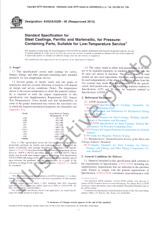We need your consent to use the individual data so that you can see information about your interests, among other things. Click "OK" to give your consent.
ASTM D7783-21
Standard Practice for Within-laboratory Quantitation Estimation (WQE)
Translate name
STANDARD published on 15.11.2021
The information about the standard:
Designation standards: ASTM D7783-21
Publication date standards: 15.11.2021
SKU: NS-1052381
The number of pages: 19
Approximate weight : 57 g (0.13 lbs)
Country: American technical standard
Category: Technical standards ASTM
The category - similar standards:
Annotation of standard text ASTM D7783-21 :
Keywords:
critical limits, matrix effects, precision, quantitation, quantitation limits,, ICS Number Code 17.020 (Metrology and measurement in general)
Additional information
| Significance and Use | ||||||||||||
|
5.1?Appropriate application of this practice should result in a WQE achievable by the laboratory in applying the tested method/matrix/analyte combination to routine sample analysis. That is, a laboratory should be capable of measuring concentrations greater than WQEZ %, with the associated RSD equal to Z % or less. 5.2?The WQE values may be used to compare the quantitation capability of different methods for analysis of the same analyte in the same matrix within the same laboratory. 5.3?The WQE procedure should be used to establish the within-laboratory quantitation capability for any application of a method in the laboratory where quantitation is important to data use. The intent of the WQE is not to impose reporting limits. The intent is to provide a reliable procedure for establishing the quantitative characteristics of the method (as implemented in the laboratory for the matrix and analyte) and thus to provide the laboratory with reliable information characterizing the uncertainty in any data produced. Then the laboratory can make informed decisions about censoring data and has the information necessary for providing reliable estimates of uncertainty with reported data. |
||||||||||||
| 1. Scope | ||||||||||||
|
1.1?This practice establishes a uniform standard for computing the within-laboratory quantitation estimate associated with 1.2?WQEZ % is computed to be the lowest concentration for which a single measurement from the laboratory will have an estimated Z % relative standard deviation (1.3?The fundamental assumption of the WQE is that the media tested, the concentrations tested, and the protocol followed in developing the study data provide a representative and fair evaluation of the scope and applicability of the test method, as written. Properly applied, the WQE procedure ensures that the WQE value has the following properties: 1.3.1?Routinely Achievable WQE ValueThe laboratory should be able to attain the WQE in routine analyses, using the laboratorys standard measurement system(s), at reasonable cost. This property is needed for a quantitation limit to be feasible in practical situations. Representative data must be used in the calculation of the WQE. 1.3.2?Accounting for Routine Sources of ErrorThe WQE should realistically include sources of bias and variation that are common to the measurement process and the measured materials. These sources include, but are not limited to intrinsic instrument noise, some typical amount of carryover error, bottling, preservation, sample handling and storage, analysts, sample preparation, instruments, and matrix. 1.3.3?Avoidable Sources of Error ExcludedThe WQE should realistically exclude avoidable sources of bias and variation (that is, those sources that can reasonably be avoided in routine sample measurements). Avoidable sources include, but are not limited to, modifications to the sample, modifications to the measurement procedure, modifications to the measurement equipment of the validated method, and gross and easily discernible transcription errors (provided there is a way to detect and either correct or eliminate these errors in routine processing of samples). 1.4?The WQE applies to measurement methods for which instrument calibration error is minor relative to other sources, because this practice does not model or account for instrument calibration error, as is true of most quantitation estimates in general. Therefore, the WQE procedure is appropriate when the dominant source of variation is not instrument calibration, but is perhaps one or more of the following: 1.4.1?Sample Preparation, and especially when calibration standards do not go through sample preparation. 1.4.2?Differences in Analysts, and especially when analysts have little opportunity to affect instrument calibration results (as is the case with automated calibration). 1.4.3?Differences in Instruments (measurement equipment), such as differences in manufacturer, model, hardware, electronics, sampling rate, chemical-processing rate, integration time, software algorithms, internal signal processing and thresholds, effective sample volume, and contamination level. 1.5?Data Quality ObjectivesFor a given method, one typically would compute the WQE for the lowest RSD for which the data set produces a reliable estimate. Thus, if possible, WQE10 % would be computed. If the data indicated that the method was too noisy, so that WQE1.6?This international standard was developed in accordance with internationally recognized principles on standardization established in the Decision on Principles for the Development of International Standards, Guides and Recommendations issued by the World Trade Organization Technical Barriers to Trade (TBT) Committee. |
||||||||||||
| 2. Referenced Documents | ||||||||||||
|
We recommend:
Technical standards updating
Do you want to make sure you use only the valid technical standards?
We can offer you a solution which will provide you a monthly overview concerning the updating of standards which you use.
Would you like to know more? Look at this page.




 Cookies
Cookies
